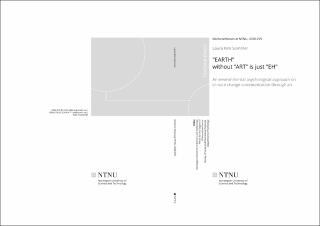| dc.contributor.advisor | Klöckner, Christian | |
| dc.contributor.advisor | Swim, Janet Kay | |
| dc.contributor.author | Sommer, Laura Kim | |
| dc.date.accessioned | 2020-10-23T10:57:35Z | |
| dc.date.available | 2020-10-23T10:57:35Z | |
| dc.date.issued | 2020 | |
| dc.identifier.isbn | 978-82-326-4947-1 | |
| dc.identifier.issn | 1503-8181 | |
| dc.identifier.uri | https://hdl.handle.net/11250/2684746 | |
| dc.description.abstract | Art is seen as a catalyst for societal change and a cultural transformation is exactly what is needed, in order to address one of the biggest challenges humankind is facing – climate change. Many environmental artists have chosen the topic in their work and want to raise awareness – but how successful are they and what impact does their art have on people?
Results of this psychological dissertation show that environmental art affects its viewers emotionally, and their thinking. When seeing a piece of climate change art, people begin to reflect on the connection between their own life and behaviour and climate change. These reflections are very important for people to feel motivated to make changes in their daily lives and to reduce their carbon footprint. It appears that the difference between a piece of climate change art and other ways of communicating about climate change, is the personal space the art gives to people. It does not provide information and instructions on how to act, but it opens the possibility for people to make a personal and emotional connection with climate change.
To find the psychological mechanism with which environmental art “works”, scientists and artists collaborated within the Climart project. For Climart several studies were done with questionnaires and statistical analyses of the data, on a wide range of art. This approach made it possible to look beyond cases of specific art and at the whole genre of environmental art, enabling identification of effective characteristics of such art. The Climart team also collaborated with the internationally renowned artist, Michael Pinsky, who created the installation “Pollution Pods”. This immersive installation was rigorously evaluated, adding to the findings of Climart and the present dissertation. Recommendations for artists and climate change campaigners are given on how to increase the impact of their creative practice or campaigns.
“Pollution Pods” was first exhibited in Trondheim in 2017, then London in 2018 and has since travelled the world, inspiring people to take action against climate change and air pollution. | en_US |
| dc.language.iso | eng | en_US |
| dc.publisher | NTNU | en_US |
| dc.relation.ispartofseries | Doctoral theses at NTNU;2020:299 | |
| dc.relation.haspart | Paper 1: Sommer, L. K. & Klöckner, C. A. (2019). Does activist art have the capacity to raise awareness in audiences? – a study on climate change art at the ArtCOP21 event in Paris. Journal of Psychology, Creativity & the Arts, Advance online publication. https://doi.org/10.1037/aca0000247 | en_US |
| dc.relation.haspart | Paper 2: Klöckner, C. A. & Sommer, L.K. (to be submitted). And once more with feeling – What role does visual art play in motivating people to climate action? | en_US |
| dc.relation.haspart | Paper 3: Keller, A., Sommer, L. K., Klöckner, C. A. & Hanss, D. (2018). Contextualizing Information Enhances the Experience of Art. Psychology of the Aesthetics, Creativity and the Arts. Advance online publication. https://doi.org/10.1037/aca0000213 | en_US |
| dc.relation.haspart | Paper 4: Sommer, L. K., Swim, J.K., Keller, A. & Klöckner, C. A. (2019). “Pollution Pods”: The merging of art and psychology to engage the public in climate change. Global Environmental Change, Vol. 59, 101992. https://doi.org/10.1016/j.gloenvcha.2019.101992 | en_US |
| dc.title | "EARTH" without "ART" is just "EH" An environmental psychological approach on climate change communication through art | en_US |
| dc.type | Doctoral thesis | en_US |
| dc.subject.nsi | VDP::Social science: 200::Psychology: 260 | en_US |

